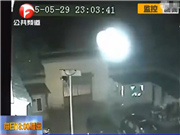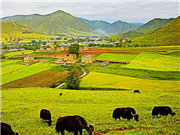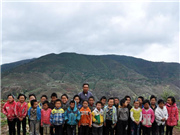

VIII. Right to a Clean and Healthy Environment
In 2014 the Chinese government gave the country's major environmental problems high priority, making considerable efforts to safeguard the people's right to a clean and healthy environment, and further exploring a new way to make ecological progress with Chinese characteristics.
The legal system for protecting the environment and eco-systems was further improved. In 2014 China made a comprehensive amendment to the Environmental Protection Law, by which governments at all levels and all enterprises are required to shoulder more responsibilities, the citizens' right to a clean and healthy environment and their duties regarding the protection of the environment are clearly defined, and a series of new mechanisms concerning closing down or distraining facilities (causing environmental pollution), total quantity control of major pollutant emissions, fines accumulating by the day, production restriction and halts, detention, environmental public interests litigation, regional joint defense against and control of pollution, and public participation are included. Specific normative regulations were also drawn up and issued to support the newly amended law, including the Rules on Investigating and Handling Emergent Environmental Incidents, Rules on Environment Information Disclosure of Enterprises and Public Institutions, Rules for Environmental Administrations in Limiting or Halting Pollution-causing Production, Rules for Environmental Administrations in Levying Fines Accumulating by the Day and Rules for Environmental Administrations in Closing Down or Distraining Pollution-causing Facilities and Equipment. These have all greatly reinforced China's legal system in the ecological and environmental field.
New progress achieved in ecological construction. In 2014 some 6.027 million ha of trees were planted all around China, among which 1.999 million ha was in the key ecological-rehabilitation projects. In addition, 96,000 ha of urban built-up areas were greened. The state improved 1.265 million ha of desertified lands, newly designated 23 counties as pilot areas for forest conservation, set up 32 national pilot desert parks, built 11 new nature reserves totaling 140,000 ha, and increased the areas of conserved wetlands by more than 500,000 ha. By the end of 2014 there were 2,729 nature reserves in China, including 428 national ones. In the same year, 17,800 cases concerning grassland damage were placed on file across the country, and 17,400 cases, or 97.6 percent, were closed; 49,000 cases of illegal encroachment on forest lands were investigated and settled, with 3,517.3 ha of forests illegally encroached upon being rehabilitated; 31,000 cases concerning forest and wildlife crimes were recorded by public security organs, among which 25,000 were solved, an increase of 14.1 percent over 2013; and 6.1 tons of illegal ivory and ivory products were destroyed publicly for the first time. In the meantime, China provided a total of 5.7 billion yuan in a project for building and protecting a national ecological security barrier in Tibet.
Remarkable results in energy conservation and emission reduction. In 2014 China made an enormous adjustment to its industrial structure, accomplishing the year's goal of abolishing outdated production capacities in 15 key industries like steel and cement, and overfulfiling the targets for scrapping yellow-labeled and outdated vehicles whose emissions were above the national standards. A goal-oriented responsibility and assessment system for air protection was gradually put in place, with the Tibet Autonomous Region, and Guangdong and some other provinces having drawn up feasible and specific measures. The Ministry of Environmental Protection gave warnings in line with the law to heads of local governments and departments that had failed to fulfill their environmental protection duties or hadn't performed them well, including the mayors of Anyang in Henan Province, Hengyang in Hunan Province, Liupanshui in Guizhou Province, Linyi in Shandong Province and Chengde in Hebei Province, and supervised their improvements. In 2014 the chemical oxygen demand, and the discharges of ammonia nitrogen, sulfur dioxide and nitrogen oxide continued to decrease, nitrogen oxide seeing the largest annual cut of 6.7 percent. The overall consumption of coal was reduced by 2.9 percent, and clean energy sources such as hydroelectricity, wind energy, nuclear energy and natural gas, rose to 16.9 percent of all energy consumption in China during the year. In China energy used to produce 10,000 yuan of GDP declined by 4.8 percent and the amount of water used to produce 10,000 yuan added value of industry decreased by 5.6 percent. The daily treatment capacity of urban sewage plants had reached 128.96 million cubic meters by the end of the year, an increase of 3.5 percent over that by the end of the previous year, and 90.2 percent of urban sewage was treated.
Punishments for activities violating environmental laws were intensified. Environmental administrations at all levels strictly executed laws concerning environmental protection, sending 2.16 million enforcement officers to inspect 840,000 enterprises, putting 12,531 cases on file and settling 8,373 of them, and particular supervision was given over the handling of 1,600 major cases. China actively explored a trans-regional and trans-river joint prevention and coordination mechanism, gradually established trans-regional joint planning, monitoring, forecasting, prevention and control systems for air and water quality in the Beijing-Tianjin-Hebei, Yangtze River Delta and Pearl River Delta areas, and improved the relevant information-sharing mechanism. Environmental departments at all levels coordinated closely with public security organs, setting up the three systems of "joint enforcement conference," "permanent liaison officers," and "consultation on and joint supervision of major cases," and the four mechanisms of "transferring cases," "joint investigation," "sharing information," and "rewarding and punishing." China introduced unmanned planes for inspecting pollution, and during the year 11 flights were made, flying more than 2,000 km and covering an area of 1,000 sq km.
The legal guarantee of the right to a clean environment was further strengthened. The Supreme People's Court established a special tribunal to hear cases related to the environment and natural resources, and stipulated a practical environmental public interest litigation system covering jurisdiction, judicial procedure, liability, compensation scope and lawsuit costs, so as to fully safeguard the right of public interest litigation of the institutions and related civil organizations as stipulated by the law. In December 2014 the Supreme People's Court announced ten typical administrative cases concerning environmental protection, including the Jincheng (Foshan) Scien Fine Materials Co., Ltd' s lawsuit against an administrative penalty meted out by the Shunde District People's Government of Foshan City, Guangdong Province for the company's alleged environmental offence. The number of cases involving environmental offences that was transferred to public security organs in 2014 exceeded the total of the previous ten years.
The channels for citizens to participate in the management of environment-related affairs were further broadened. The amended Environmental Protection Law stipulates that: The environmental departments should disclose information about the environment and improve their procedures, so as to facilitate the public's participation in and supervision of environmental protection; the environmental NGOs which have registered with the civil affairs authorities at municipalities which contain districts or above, which are engaged in environmental protection for the public interest and have no law violation records for five consecutive years are eligible to file environmental public interest lawsuits to the people's courts, and the latter should accept and hear all lawsuits filed by eligible NGOs. Governments at all levels also actively explored ways of soliciting public opinions through online platforms, questionnaire surveys, hearings and reviewing panels. Since January 1, 2014 the national air quality real-time announcement website has released 150,000 pieces of information on the air quality in cities. The Ministry of Environmental Protection listened to and dealt with the public's complaints on environmental offences through the "12369" hotline. By the end of 2014 the hotline had handled 1,463 complaints from the public, and settled all of them on time. The ministry issued the Notice on Better Disclosure of Information Related to Emergent Environmental Incidents, requiring related departments to publish the names of reported offending enterprises, their problems and the handling of their problems in the China Environment News and the website of the ministry every month. By the end of 2014, the handling of 1,479 complaints (including those received in 2013 but settled in 2014) and 33 typical cases had been made known to the public.
 |
Day|Week

 Stunning pictures of Chinese Navy
Stunning pictures of Chinese Navy UFO spotted hovering over a temple in E China
UFO spotted hovering over a temple in E China Getting close to PLA's first professional 'Blue Army'
Getting close to PLA's first professional 'Blue Army' Picturesque Xinduqiao town in SW China
Picturesque Xinduqiao town in SW China Tsinghua junior makes over 10,000 yuan a day by selling alumnae's used quilts
Tsinghua junior makes over 10,000 yuan a day by selling alumnae's used quilts Graduation photos of students from Zhongnan University
Graduation photos of students from Zhongnan University A school with only one teacher in deep mountains
A school with only one teacher in deep mountains Glimpse of cultural heritage "Xilankapu"
Glimpse of cultural heritage "Xilankapu"